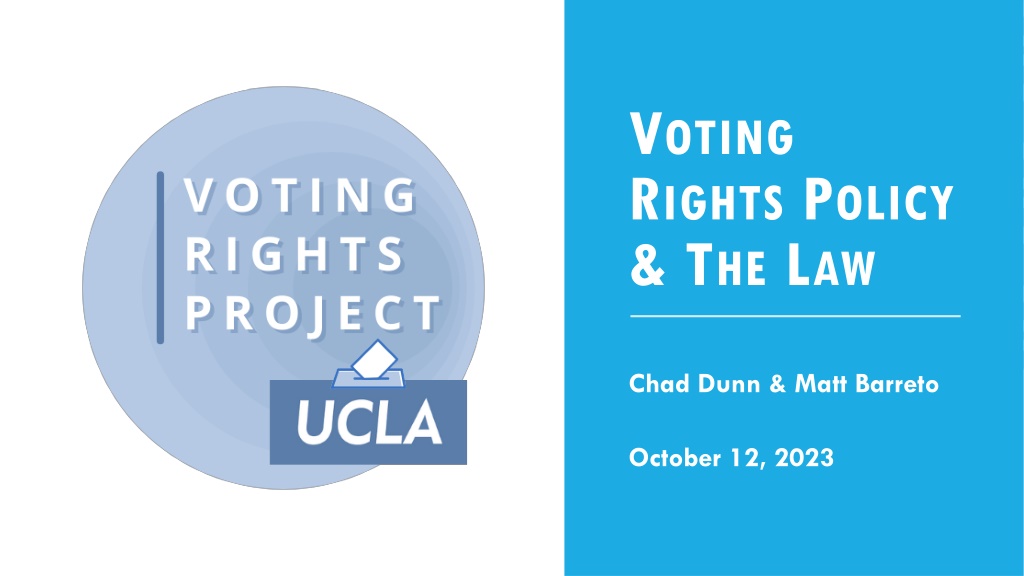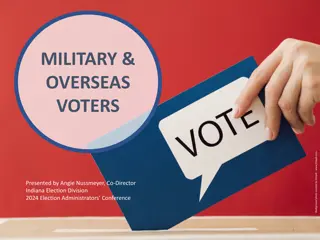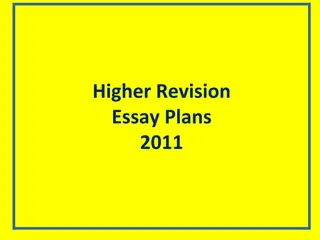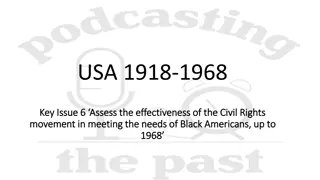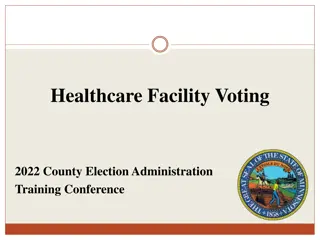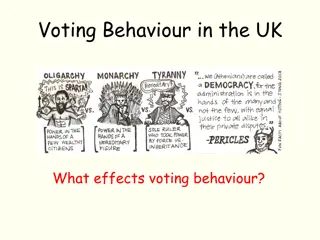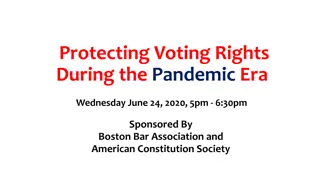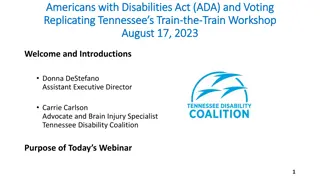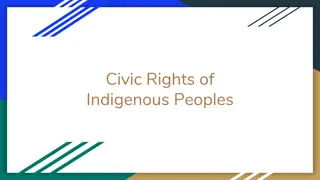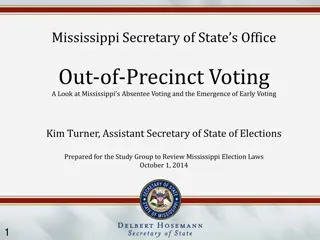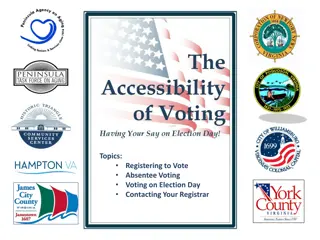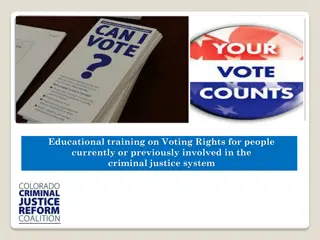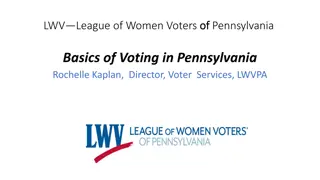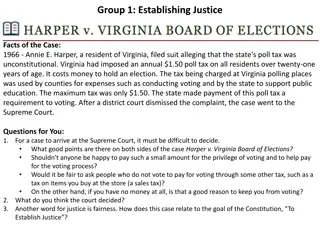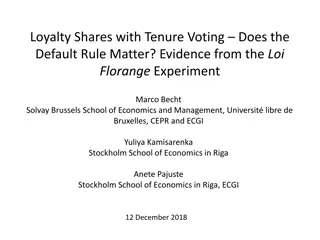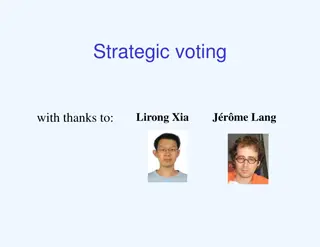Understanding Voting Rights Policy and Law: Insights and Cases
Delve into the intricate world of voting rights policy and law through discussions on race-based claims, key legal cases like Terry v. Adams, and current voting rights news. Explore the nuances of intent, effects, and historical context shaping voting rights legislation and practices.
Download Presentation

Please find below an Image/Link to download the presentation.
The content on the website is provided AS IS for your information and personal use only. It may not be sold, licensed, or shared on other websites without obtaining consent from the author. Download presentation by click this link. If you encounter any issues during the download, it is possible that the publisher has removed the file from their server.
E N D
Presentation Transcript
VOTING RIGHTS POLICY & THE LAW Chad Dunn & Matt Barreto October 12, 2023
OVERVIEW Race Based Voting Rights Claims Terry v. Adams direct intent example Arlington Heights factors (circumstantial intent) Review standards in Gingles v. Thornburg (effects) Population deviation - one-person, one-vote Patino vs. City of Pasadena 1. 2. 3. 4. 5. 6. But first any voting rights / redistricting in the news?
VOTING RIGHTS NEWS Alexander v. South Carolina State Conference of the NAACP October 11 Oral Argument https://www.supremecourt.gov/oral_arguments/argument_transcripts/2023/22-807_7mi8.pdf 1. In re: Jeff Landry, et al. - Louisiana Supreme Court Stay Application 2. North Carolina VBM - returned mail provision 3.
VOTING RIGHTS RACE BASED CLAIMS 14th Amendment Racial Gerrymandering Claim (Racial Predominance Claim) (Shaw v. Reno (1993)) 14th/15th Amendment Direct Intent Case (Terry v. Adams (1953)) 14th/15th Amendment Circumstantial Intent (Arlington Heights (1977) Factors) VRA Section 2 Intent (52 U.S.C 10301(a)) (Arlington Heights (1977) Factors) VRA Section 2 Effects (52 U.S.C 10301(b)) (Gingles (1986) Factors) One person, one vote (Baker v Carr (1962); Reynolds v. Sims (1964)) 1. 2. 3. 4. 5. 6.
TERRY V. ADAMS, 345 U.S. 461, 464-65 (1953) "Q. And if you held yours at that time, they would have to vote too, wouldn't they?" "A. Why sure." "Q. And you hold it in May so they won't have to?" "A. Well, they don't vote in ours, but they can vote on anybody in the July election they want to. " "Q. But you are not answering my question. My question is that you hold yours in May so you won't have to let them vote, don't you?" "A. Yes." "Q. And that is your purpose?" "A. Yes." "Q. And your intention?" "A. Yes." "Q. And to have a vote of the white population at a time when the negroes can't vote, isn't that right?" "A. That's right." "Q. That is the whole policy of your Association?" "A. Yes." "Q. And that is its purpose?" "A. Yes." "Q. . . . Now Mr. Adams, will you tell me specifically what is the specific purpose of holding these elections and carrying on this [Jaybird] organization like you do? "A. Good government." "Q. Now I will ask you to state whether or not it is the opinion and policy of the Association that to carry on good government they must exclude negro citizens?" "A. Well, when we started, it was, and it is still that way, I think." "Q. And then one of the purposes of your organization is for the specific purpose of excluding negroes from voting, isn't it?" "A. Yes." "Q. And that is your policy?" "A. Yes." "Q. I will ask you, that is the reason you hold your election in May, rather than in June or July, isn't it?" "A. Yes." "Q. Because if you held it in July, you would have to abide by the statutes and the law by letting them vote?" "A. They do vote in July."
ARLINGTON HEIGHTS Village of Arlington Heights v. Metropolitan Housing, 429 U.S. 252 (1977). Who can tell us the facts of this case?
ARLINGTON HEIGHTS MHDC, using federal dollars, desires to build low to moderate income housing in the Village. Under their contract, they must obtain rezoning of the target plot of land from single family, to multi-family. In considering the re-zoning application, the Village Commission held three public hearings after which it recommended to the Village s Board of Trustees that the application of MHDC be denied due to the fact that the Commission concluded that low-income housing would be unsuitable in the proposed location. The Board of Trustees then denied the rezoning application. MHDC sued asserting claims under the 14th Amendment and the Fair Housing Act The Supreme Court held that MHDC had only met its burden of proof to show racially discriminatory effects but, after analyzing a series of factors, MHDC had not proven racially discriminatory purpose. Purpose can be shown by direct and/or circumstantial evidence and the Supreme Court provided a list of factors for courts to consider in the absence of direct evidence. The case was remanded to determine whether MHDC had stated a claim of discrimination under the Fair Housing Act statute.
ARLINGTON HEIGHTS BROAD TEST Court applied a discriminatory intent test the official action affects a protected class in greater proportion than others, and if such is established; that the official action was intended to discriminate against a suspect or protected class. 1) 2) Provided Non-exhaustive factors The Court must be careful that it does not miss[] the forest in carefully surveying the many trees. N.C. State Conf. of NAACP v. McCrory, 831 F.3d 204 (4th Cir. 2016)
ARLINGTON HEIGHTS FACTORS The impact of the official action, especially whether it bears more heavily on one race than another (but impact alone is not determinative ) 1. The historical background of the decision, particularly if it reveals a series of official actions taken for invidious purposes 2. The specific sequence of events leading up the challenged decision 3. Departures from the normal procedural sequence or [s]ubstantive departures 4. The legislative or administrative history . . .especially where there are contemporary statements by members of the decision-making body, minutes of its meetings, or reports 5.
ARLINGTON HEIGHTS APPLIED TO DISTRICTING Analysis of the racial impact of cracking and packing decisions within the plan Court rulings on past decade districting efforts as well as history of vote denial devices in the jurisdiction Analysis of events leading up to the district plan, for example, was there a policy issue (school segregation, immigration) debated that flamed tensions heading into redistricting How was this districting plan adopted in comparison to how the body adopts other laws and policies What did supporters (and sometimes opponents) say publicly about why they were supporting this districting plan. were the comments credible or pretext, suggesting an alternative motive 1. 2. 3. 4. 5.
ARLINGTON HEIGHTS APPLIED TO VOTE DENIAL Analysis of the IDs deemed acceptable including their possession rates by race. What are the possession rates of IDs not considered acceptable History of vote denial devices as well vote dilution efforts in the jurisdiction. If the jurisdiction engages in invidious discrimination in other matters like housing, public benefits and voting, it probably did here as well. What were the factual circumstances giving rise to the call to impose the ID requirement. Were the concerns fanciful or well founded. Were other racially charged policy matters on the agenda around the same time Was the ID requirement passed in the normal course or was the legislative process adjusted in some way to help it along suggesting that the views of the racial and/or political minority was intentionally stifled in this context What did proponents argue was the motivating factor for the ID requirement. Was there any evidence of fraud? Was the law designed to precisely or even directly address that fraud. For example, one argument is that undocumented people would be stopped from voting but some of the IDs deemed acceptable could be obtained by undocumented people 1. 2. 3. 4. 5.
REVIEW EFFECTS TEST Liability can be established premised upon discriminatory effects or discriminatory intent. Gingles Preconditions Thornburg v. Gingles, 478 U.S. 30 (1986) Is the minority group sufficiently large and geographically compact to constitute a majority in a single-member district? Is the minority group politically cohesive? Does the white majority vote sufficiently as a bloc to enable it-in the absence of special circumstances-usually to defeat the minorities preferred candidate? Lack of proportionality? Johnson v. DeGrandy, 512 U.S. 997 (1994) 1. 2. 3. 4.
REVIEW EFFECTS TEST Totality of the Circumstances/Zimmer factors to consider: Gingles, 478 U.S. 30, 36-38 (citing Senate Report 97-417) The extent of any history of official discrimination with respect to the minorities right to vote The extent to which potentially discriminatory voting practices or procedures, like majority voting requirements or anti-single shot provisions, have been used. If there is a candidate-slating process, whether minority candidates have been denied access to it. The extent to any discrimination against minorities in education or other areas, which might hinder effective participation in the political process. Whether political campaigns have been characterized by racial appeals. The extent to which minority group members have been elected to public office. Whether there is a lack of responsiveness on the part of elected officials to the minority groups particularized needs. Whether the policy of supporting the use of voting policy or practice is tenuous 1. 2. 3. 4. 5. 6. 7. 8.
EQUAL PROTECTION 14TH AMENDMENT Equal Protection 14th Amendment Claim A state (or local) redistricting plan with population deviations among districts that are greater than 10% is prima facie unconstitutional. Jurisdiction J has total pop of 100,000 and 5 districts Each district should have 20,000 people Smallest possible is 19,000 (-5%) Largest possible is 21,000 (+5%)
EQUAL PROTECTION 14TH AMENDMENT Equal Protection 14th Amendment Claim A state (or local) redistricting plan with population deviations among districts that are greater than 10% is prima facie unconstitutional. A federal redistricting plan (US House) must be as close to equal as possible
PATINO V. CITY OF PASADENA, TX Vote dilution and gerrymandering case City was 62% Latino; 48% CVAP; 42% registered City had 8 single-member districts Latinos started to elect candidates of choice Post Shelby County v. Holder, Mayor Isbell proposed going to 2 at-large and 6 single-member districts Court held that this dilutes Latino vote; 6 districts were a racial gerrymander (packing)
NEXT STEPS & UPDATE ON YOUR JURISDICTIONS Provide detail on 2 jurisdictions Report both Total Pop AND CVAP detail Report data for both 2010 and 2020 Look for maps of your jurisdiction (districts? precincts?) Add election detail Who are current incumbents? Who has run and results of last 4 elections for this office Look for Arlington Heights factors in your locale Read Karlan, 24 Harv. CR-CL L.Rev 173 (1989) Maps and Misreadings
VOTING RIGHTS POLICY & THE LAW Matt Barreto & Chad Dunn October 12, 2023
